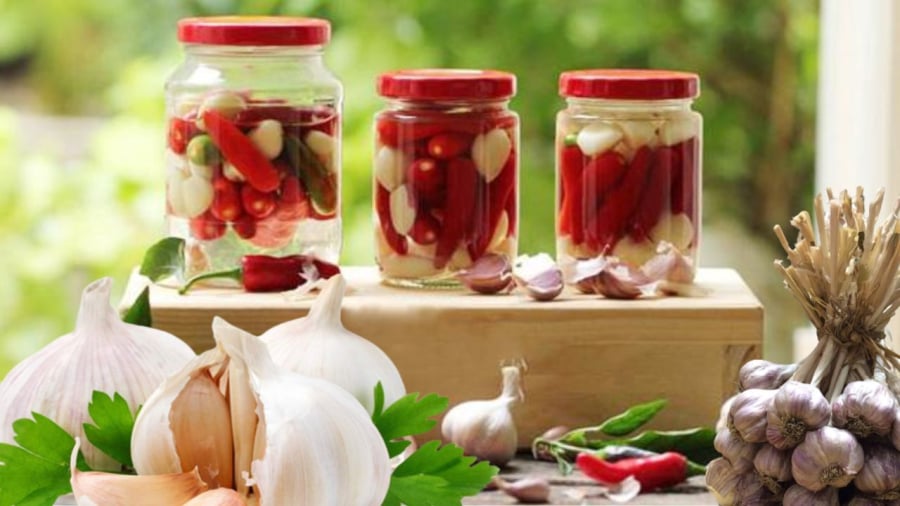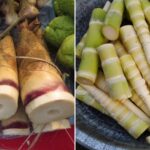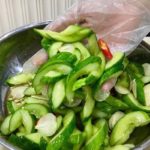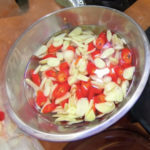Why Does Pickled Garlic Turn Green?
Pickled garlic in chili vinegar is a condiment that enhances the flavor of dishes, especially pho, bun, and rieu. However, the garlic cloves turning green can be off-putting and even give the impression of being unsafe to consume.
In reality, the greening of garlic is a natural reaction that occurs when the cloves are exposed to air after peeling and slicing. If the garlic is young and has a higher moisture content, the oxidation process can turn it green. While this discoloration does not indicate toxicity, it is aesthetically unappealing.

Selecting and Preparing Garlic Is Crucial
Tips for Pickling Garlic to Prevent Greening, Ensure Crispness, and Avoid Scum
Prepare the Right Ingredients for Pickling Garlic
Choose 200g of garlic or adjust the quantity according to your needs. For the best flavor, select firm, older garlic bulbs with smaller cloves as they tend to be more aromatic. Purple-skinned garlic is generally more fragrant than white-skinned varieties. Solitary bulbs are tastier than multi-cloved ones but tend to be more expensive.
Get a 500ml bottle of good-quality vinegar. Avoid industrial vinegar with a harsh smell; instead, opt for a natural variety to ensure the pickling liquid is tasty and gentle on the stomach.
For the peppers, you can use bird’s eye chilies for heat or horn peppers and bell peppers for a milder, sweeter flavor.
Other ingredients include salt, water, and a glass or ceramic jar. Avoid using plastic containers. Sterilize the jar by washing it thoroughly and scalding it with boiling water, then allow it to air dry.
Tips for Preparing Garlic to Prevent Greening
To simplify the peeling process, you can microwave the garlic for about 10 seconds. After peeling, slice the garlic into moderately thin pieces; avoid cutting them too thin or thick, depending on how soon you plan to eat them.
Rinse the sliced garlic and soak it in a dilute salt and sugar solution for about 30 minutes. Change the solution and soak the garlic for another cycle. This process helps prevent the garlic from turning green when pickled and reduces its distinctive pungency.
If desired, you can further sterilize the garlic by scalding it briefly in boiling water and then letting it air dry.

Soaking Garlic in Water Multiple Times Helps Prevent Greening
Rinse the peppers, remove the seeds, and slice them. The amount of pepper used depends on your preference for spiciness. You can omit the peppers if desired. For a softer texture and a more evenly colored pickling liquid, blend or crush the peppers.
Combine vinegar, water, and a little sugar in a saucepan and bring it to a boil. The heat will help dissipate the harsh vinegar smell, resulting in a more refined flavor. Adding sugar also enhances the taste and speeds up the pickling process. Alternatively, you can opt for a direct pickling method using 100% vinegar without adding water or sugar. However, ensure that the vinegar is of good quality and free from industrial chemicals.
Pickling Process
Thoroughly clean and dry a glass or ceramic jar, and if desired, sterilize it by boiling it in water. Allow the jar to cool before adding the garlic and pepper. Then, pour in the pickling liquid (cooled to room temperature) to cover the contents.
Seal the jar and let it sit for 2-3 days before using. Avoid exposing the jar to direct sunlight or heat, as this can cause the garlic to sour prematurely and lose its crispness.
When serving, use a clean spoon to remove the desired amount of pickled garlic, avoiding any food residue or grease that could contaminate the remaining pickles and cause scum formation.



































